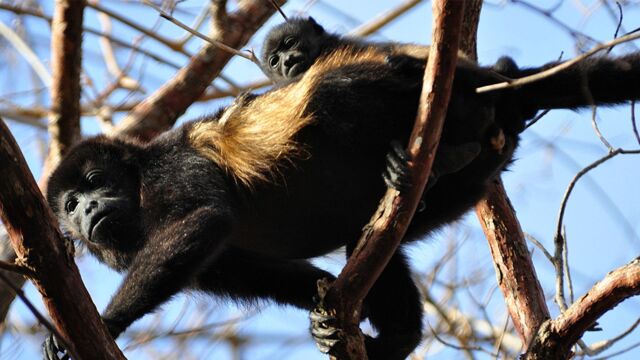They scream, move and haven’t been wearing yellow for that long... Any resemblance to the French social news is however purely fortuitous! It is not a question of human beings expressing their anger, but of an entirely different type of primate: the golden-mantled howling monkey or mantled howler, Alouatta palliata. A species native to Latin America, who seems about to trade his dark fleece against a fur that is marked with bright yellow stains.
Discover our latest podcast
A study published recently in the Mammalian Biology journal is devoted to the strange phenomenon that has been affecting these little South American monkeys for about five years: yellow spots are beginning to appear on the black coat that covered their tail and paws up until then. A sudden change of pigmentation, which most likely points to human intervention.
To try to clarify the mystery of this sudden golden colouration, researchers have started analysing some of these howler monkeys’ hairs whose spots never stop growing, both in size and quantity. As a result, the fur of Costa Rican primates has been found to contain a pigment that was previously absent from their hair: pheomelanin.
A pigment in full mutation
This molecule seems to gradually take the place of its predecessor, eumelanin. This more common pigment is responsible for the brown or black hair colouring. This is an unexpected and exclusive discovery about these wild monkeys, as the researchers point out in their publication:
‘These observations represent completely abnormal pigmentation cases, since they have never been seen in captivity or in nature before, and we are not aware of similar pigmentation changes in other primates or other mammal groups.’
Pesticides probably responsible for the phenomenon
Faced with this strange situation, the scientists were quick to identify a suspect: Humans. Or more precisely, the pesticides used by farmers in this very rich agricultural region: pineapple, banana or palm trees used for oil production.
Many of the synthetic products that are sprayed to protect future crops contain a key element: sulfur. A substance that, when it interacts with melanin, causes a change in its structure and thus creates the famous pheomelanin, identified by researchers in the yellowish parts of the screaming monkeys' fur.
As a result, it is not surprising that gold stains are multiplying at a rate never seen in Costa Rican primates: the country is indeed one of the biggest users of pesticides, with more than 25 kilograms of treatment products spread on each hectare of cultivated land, according to Pesticide Action Network UK statistics.
Feeding almost exclusively on leaves soiled by pesticides, Costa Rica's howler monkeys would at the same time ingest ever larger quantities of sulfur. A substance that would creep deep into their cells, and turn the colour of their coat yellow.
Even if this mechanism remains partly hypothetical, its visible consequence - the colour change of the primates’ fur - makes them more vulnerable to the attacks of predators... Jaguars in particular, which thus locate their prey more and more easily in the darkness of the forest.
And the trend does not seem to be ending there: the proportion of blonde fur is, according to the latest observations of researchers, constantly increasing. It would have even reached the entire body of some howler monkeys now. Target of choice for predators... Dressing up in yellow, definitely a safety issue for monkeys.















